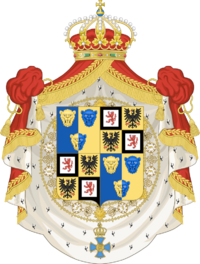Coat of arms of Durland
| Coat of arms of Durland | |
|---|---|
 Greater (royal) version | |
| Versions | |
 Lesser (state) version | |
| Armiger | Carilla, Queen of Durland |
| Adopted | 9 April 1928 |
| Torse | tasseled strings Or |
| Blazon | Per pale Azure and Or two lions rampant all counterchanged within a bordure argent. |
| Orders | Order of Prince Jora |
| Other elements | The monarch places this coat of arms on a mantle gules lined with Ermine. Above the mantle is a pavilion gules again topped with the royal crown. |
The coat of arms of Durland is the arms of dominion of queen Carilla of Durland, and is used to represent both the monarch and the kingdom. It depicts two lions countercharged onto a vertically-divided shield of blue and gold, within a white border (Per pale Azure and Or two lions rampant all counterchanged within a bordure argent.)
The coat of arms is used by the Queen, Parliament, and the Supreme Court. Members of the Royal Family use the arms charged with a label of difference and a crown of rank. The government uses a variation of the arms, without the mantle and with the shield crowned, which is known as the state arms.
Description
The current coat of arms was adopted in 1928 following the re-establishment of the monarchy. It is closely modelled on the coat of arms previously used from 1878 until 1922. As per the registration with the Court of Arms of the Kingdom, the escutcheon is blazoned: Per pale Azure and Or two lions rampant all counterchanged within a bordure argent. The shield is surrounded by the insignia of the Order of Prince Jura, and all surrounded by mantling Gules doubled ermine, crowned with the royal crown and tied up with tassled strings Or.
It was designed by King Garmanas II, who possessed a personal interest in heraldry. The design is based on the historical arms of Prince Jora, Grand Prince of the Durlish Principalities. The inclusion of a white border (bordure argent) was at the insistence of the King and drew on the practice of using a border to denote a second child. The king described the meaning of the border as follows:
The first son - the son that should have claimed succession to the great power and glory of the Durlish principalities - died when he was brutally and criminally overrun and taken by the colonial powers. The Durland that could have been, had it been allowed to maintain its sovereignty, never had any opportunity to succeed to its ancient glory. We are the second son - forgotten and supposedly destined to stand in the background. Thanks to God's providence and the strength of our people, we have once more taken control of our own destiny. The second son is now King.
The rules outlining the design and use of the coat of arms, including variations and eligibility, continue to be based on those made by Garmanas II.
Variants
Royal versions
Gallery
- Coats of arms of the Monarch
- Coats of arms of members of the Royal House
- Coat of arms of members of the Royal Family and other variants











